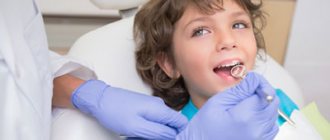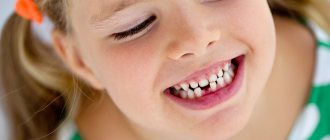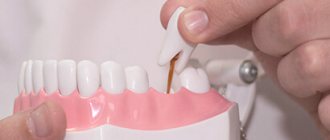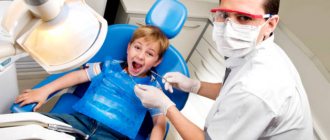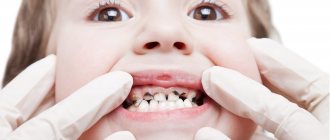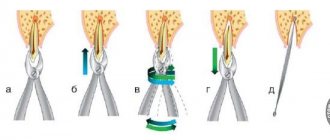PHOTO: The result of early removal of anterior milk teeth in children. The central primary incisors of the upper jaw were removed at the age of 3 years for emergency reasons.
Early tooth extraction is defined as the removal of a baby tooth 2 years or more before it naturally falls out and is replaced by a permanent tooth. So, for example, the removal of the 4th milk tooth at the age of 6 is early, since this tooth should normally be in the dentition until the age of 9-10.
The main reason for the early removal of baby teeth is the inability to cure the tooth due to severe destruction, fracture of the baby tooth or the spread of the inflammatory process to surrounding tissues (which creates a risk of damage to the permanent tooth germ).
Early removal of chewing baby teeth in children creates conditions for the displacement of adjacent baby teeth into the resulting space. Thus, space is lost where the corresponding permanent tooth will have to erupt. There is a malocclusion of the teeth. For example, the removal of the 4th milk tooth at the age of 3-5 years will lead to the displacement of the 5th milk tooth into the area of the removed 4th milk tooth. When the time comes, there will be nowhere for the 5th permanent tooth to erupt, since its place is occupied and it will begin to push nearby teeth apart. As a result, crowding of teeth will form in the area of the chewing permanent teeth. It also creates inconvenience when chewing food.
PHOTO: Children's orthodontic plate for the upper jaw with artificial teeth. The plate is fixed on the upper jaw using metal clasps, which are not visible from the outside.
Previous removal of the primary incisors on the upper jaw leads to the formation of an aesthetic defect and a lisp in the child, incorrect pronunciation of whistling sounds (“z”, “s”, “ts”) and hissing sounds (“zh”, “ch”, “sh”, “shch”) ") sounds.
When do baby teeth start falling out?
During the first three years of life, a child grows 20 baby teeth. At this time, a temporary bite is formed: it is distinguished by a pronounced anatomical shape, thin enamel, and susceptibility to caries. After the first three years, the roots of baby teeth slowly dissolve, making room for a permanent bite. From the age of 4-5 years, baby teeth begin to fall out, and this continues until the fifth or sixth grade of school.
In most cases, the process occurs calmly and does not require third-party intervention, including medical attention. Dentists strongly advise against rushing things.
Recommendations after removal
Immediately after removal, the wound formed at the site of the tooth may bleed; the doctor will definitely warn you about this. To avoid additional infection, as well as to stop bleeding as quickly as possible, you should refrain from eating food, carbonated, sweet, hot and cold drinks for a couple of hours. It is best to quench your thirst with plain water and drink it through a straw.
Also, the dentist, if necessary, may suggest installing a space retainer to maintain an even dentition or make modern plates with artificial teeth. This will allow you not to disturb the aesthetics and functionality of the dentition.
Why shouldn't you remove baby teeth yourself?
Removal of a baby tooth is considered premature if more than a year remains before a new one appears. This period is difficult to predict accurately, but you can roughly estimate it using a graph with average indicators.
Premature removal of a baby tooth is dangerous because its neighbors will try to take the vacant space. The roots of permanent teeth that are about to emerge will become crowded. The bite will change, which will take a long time to correct. Moreover, there are several strict contraindications for extracting baby teeth:
- Acute inflammatory diseases of the oral cavity.
- Inflammatory diseases of the throat (ARVI, sore throat, etc.).
- It is not recommended to remove teeth for pathologies of the cardiovascular system, kidneys, central nervous system, blood diseases, vitamin deficiency and nutritional dystrophy.
So when your child's first baby teeth start to loosen, don't disturb them and let them fall out naturally. The child's body knows its business.
When a tooth is already loose, it needs to be cleaned very carefully so as not to rush things. If your child is still in kindergarten and his motor skills are not well developed, help him: take ASEPTA® Baby dental wet wipes and wipe the tooth (as well as its neighbors) from the top and sides.
Application of anesthesia
If the tooth is very loose, then most likely you will not need pain relief, but the doctor may suggest topical anesthesia (spray or gel), as well as infiltration anesthesia (an injection with an anesthetic drug).
General anesthesia can be used:
- for children 1-4 years old;
- children with mental illness;
- with organic brain damage;
- if you are intolerant or allergic to local painkillers.
Baby teeth are very important for the formation of the bite, as well as the health of permanent teeth, so only a pediatric dentist at a dental clinic should decide on their premature removal.
Indications for milk tooth extraction
However, there are several cases when teeth definitely need to be helped to fall out. For example:
- Bottle caries or other caries has damaged more than half of the tooth.
- The tooth has been loose for a long time, but cannot fall out. This makes it uncomfortable for the baby to chew.
- The tooth is broken, the sharp edge scratches the cheek or tongue.
- The root is affected by caries (there is a danger that it will damage the permanent tooth underneath).
- Pulpitis.
- There is inflammation or a cyst on the mucous membrane next to the tooth.
Do not make the decision to remove it yourself: if you see the symptoms listed above, contact your pediatric dentist. He will tell you what treatment is required.
Trying to remove baby teeth yourself at home is dangerous: their thin walls and long roots go too deep into the gums. If you pull out a tooth with a thread or other improvised methods, you can easily disrupt the growth of permanent teeth that are hidden under the milk teeth.
Reasons for tooth extraction in children
Dentists have to prematurely remove about 50% of children's primary teeth, and almost all cases involve complications of caries (periostitis, periodontitis, osteomyelitis).
Also reasons for deletion may be:
- periodontal diseases,
- injuries,
- eruption of molars without loss of primary teeth,
- fistula on the gum.
Some doctors, in order to prevent displacement of the dentition, offer a prosthesis instead of an extracted baby tooth, and if several are removed at once, put a plate on the teeth, a crown made of metal or plastic, so that the permanent teeth will grow in their place.
What to do after removing a baby tooth?
The dentist will provide detailed recommendations based on your child’s jaw development. Below are general tips that will help your gums recover as quickly as possible.
- After a baby tooth is removed, a blood clot appears in its socket, which helps the gum heal faster and protects it from dirt. Therefore, rinsing your mouth is not recommended. The clot may become dislodged.
- The tampon that the doctor left in your mouth should be carefully spat out after 20 minutes.
- Ask your child not to bite his cheek in the area of anesthesia. When it “comes off”, painful sensations may appear.
- For a couple of days it is better to abstain from hot foods and fermented milk products, which create an environment beneficial for bacteria.
- During the first week, you should avoid heavy physical activity (especially swimming and running).
- Do not go to the bathhouse or sauna for a week.
- On the first day, it is better to eat soft, cold food.
- Help your child brush his teeth. Use only a soft brush.
Removal without pain
In pediatric dentistry, it is very important to ensure the child’s comfort during the tooth extraction procedure. This applies to all stages of treatment. To prevent the baby from being afraid, double anesthesia is used:
- Anesthetic gel. It is necessary to reduce the sensitivity of the gums and prepare for further anesthesia.
- Injection anesthesia. After the gel begins to take effect, the nurse will inject an anesthetic into the gum. Thanks to the action of the gel, the child does not feel pain from the injection.
Many drugs for local anesthesia, which are used to anesthetize tooth extraction, are strong allergens. In order to exclude the possibility of an allergy, the child is given a skin test.
How to go to the dentist, remove a baby tooth and not scare your baby?
It is recommended that a child’s baby teeth be removed by pediatric dentists: it will be painless, safe and timely. For everything to go smoothly, a visit to the dentist should be associated with something pleasant and calm. Modern dentistry has a friendly atmosphere, new painkillers have appeared, and instruments (especially in children's offices) do not inspire fear.
Finally, our advice: don’t worry and don’t let your child worry. The calmer you are about going to the dentist, the calmer your baby will behave. Stay nearby in the dentist's office, because parental support is extremely important to him.
Tooth extraction: complications
Sometimes complications can occur after tooth extraction. What parents should pay attention to:
- if the baby has unbearable and prolonged pain;
- bleeding does not stop, the blood is bright scarlet;
- the child has severe swelling, which makes it difficult to swallow;
- the baby complains of immobility (numbness) of the jaw for more than 2 days;
- temperature above 38ºС.
If you notice that your child feels unwell after tooth extraction, contact a specialist immediately!
Removal of a permanent tooth in a child is always done only for emergency reasons, when other methods of treatment and restoration cannot be performed. Take care of the health of your children's teeth!
Contraindications
Tooth extraction is not recommended in the following cases:
- Acute inflammatory process in the mouth: gingivitis, stomatitis, sore throat;
- Acute infectious diseases of the body: chicken pox, scarlet fever, whooping cough, influenza, ARVI;
- For serious diseases of the body: epilepsy, oncology, heart defects, heart failure;
- For blood diseases that are accompanied by clotting disorders;
- If possible, treat the tooth therapeutically.
How does tooth extraction occur under anesthesia?
To prepare for surgery, a preliminary visit to the pediatrician and a comprehensive examination are necessary.
Next, you need to follow these steps:
- Preparation at home. The child should not eat 6 hours before the doctor’s appointment, and drink water 2 hours before the doctor’s appointment.
- Anesthesia. Immersion in a state of medicated sleep by administering the drug occurs under the supervision of an anesthesiologist (a specialist is nearby until the patient is induced).
- Delete. Includes extracting the tooth itself and its roots, checking the complete removal of all roots, and treating the wound.
- Coming out of anesthesia.
After waking up, the child remains under the supervision of specialists for several more hours. Parents receive doctor's recommendations.
Consequences of early removal
In primary occlusion, the chewing teeth are usually the first to begin to deteriorate, and they must last at least ten years before falling out. Unfortunately, after their removal, the process of eruption of permanent teeth does not accelerate - after all, they are still in an immature state in the jawbone, their roots have not yet been formed.
As a result of the removal of baby teeth:
- The child is deprived of the opportunity to fully chew food. The anterior part of the dentition cannot cope with the load placed on it. Some food is swallowed in an insufficiently crushed form. This leads to diseases of the gastrointestinal tract.
- The chewing muscles receive uneven load, which affects the development of the jaw bones. Those parts of the jaw that are excluded from the chewing process due to the absence of teeth slow down their growth. This is how maxillofacial anomalies arise that require long-term orthodontic treatment.
- If baby teeth are removed long before the time of change of bites, then the eruption of their permanent counterparts is difficult due to the presence of a thick layer of bone on the alveolar process. In this case, the teeth erupt either outside the dental arch (dystopia) or even become immured in the jaw (retention).
- The first permanent tooth, the “six”, appears at 6 years of age. The entire permanent dentition is aligned along it. If there are no milk teeth in front of the “six”, then it moves closer to the center of the jaw, and there is not enough space for the remaining teeth. This results in crowding of teeth in the anterior region, which is a serious cosmetic drawback.
- Underdevelopment of the jaw occurs as a result of shortening of the dentition. Underdevelopment of the jaws is manifested in a violation of the proportions of the face, a change in the configuration of its parts. Psychological complexes are formed that require long-term treatment from a specialist.
- Problems with diction appear, and hence the psychological discomfort that the child experiences when communicating with peers.
- Dystopia leads to periodontitis – inflammation of the soft and bone tissues surrounding crowded teeth.
- Inflammatory processes in the periodontium and intestines cause a decrease in immunity. Due to frequent colds, the child’s mental and physical development slows down.
Taking good care of baby teeth in childhood will save you from many problems in the future.
Treatment at the SHiFA clinic
The Shifa clinic employs experienced pediatric dentists, who in their activities are guided by the principle “noli nocere” - do no harm!
Sparing no time and effort, specialists fight for every tooth, trying to extend its service life. They convince parents and children of the need to preserve the integrity of the dentition. The skill and painstaking work of professionals brings excellent results - painless and high-quality treatment of primary occlusion becomes a guarantee of the harmonious development of the maxillofacial area.
Opportunities of modern pediatric dentistry
Just recently, no one thought about the fact that a child’s teeth should be treated as painlessly as possible. Treatment for the baby should take place in a psychologically comfortable environment. That nothing bad will happen, he will cry and forget. This is why there are so many adults who are afraid of dentists. They go only when the teeth hurt so much that it is no longer possible to endure.
Now there are many specialized children's dental clinics that take into account the psychological and physiological characteristics of children. These dentists do not resemble hospitals. On the contrary, their interiors are decorated in a children's style. This creates a relaxing environment for kids. These clinics are staffed by dentists and paramedical personnel. They specialize in treating young patients and know their psychological characteristics. In these medical institutions, only modern, gentle methods of treating dental diseases are used, and modern anesthesia is used. If the baby is completely unable to withstand the treatment, it is carried out under anesthesia.
Contraindications
Tooth extraction is not recommended in the following cases:
- Acute inflammatory process in the mouth: gingivitis, stomatitis, sore throat;
- Acute infectious diseases of the body: chicken pox, scarlet fever, whooping cough, influenza, ARVI;
- For serious diseases of the body: epilepsy, oncology, heart defects, heart failure;
- For blood diseases that are accompanied by clotting disorders;
- If possible, treat the tooth therapeutically.
Peculiarities
Babies' first teeth appear at one year of age. By the age of three, they have grown a full set of them.
They have their own characteristics:
- thin enamel layer;
- loose structure of dental and gum tissue;
- undeveloped local immunity;
- high degree of tissue vascularization.
For these reasons, children's teeth and gums are more susceptible to the pathological effects of bacteria. Inflammatory processes occur faster in them, infection spreads faster, and complications occur more often.
